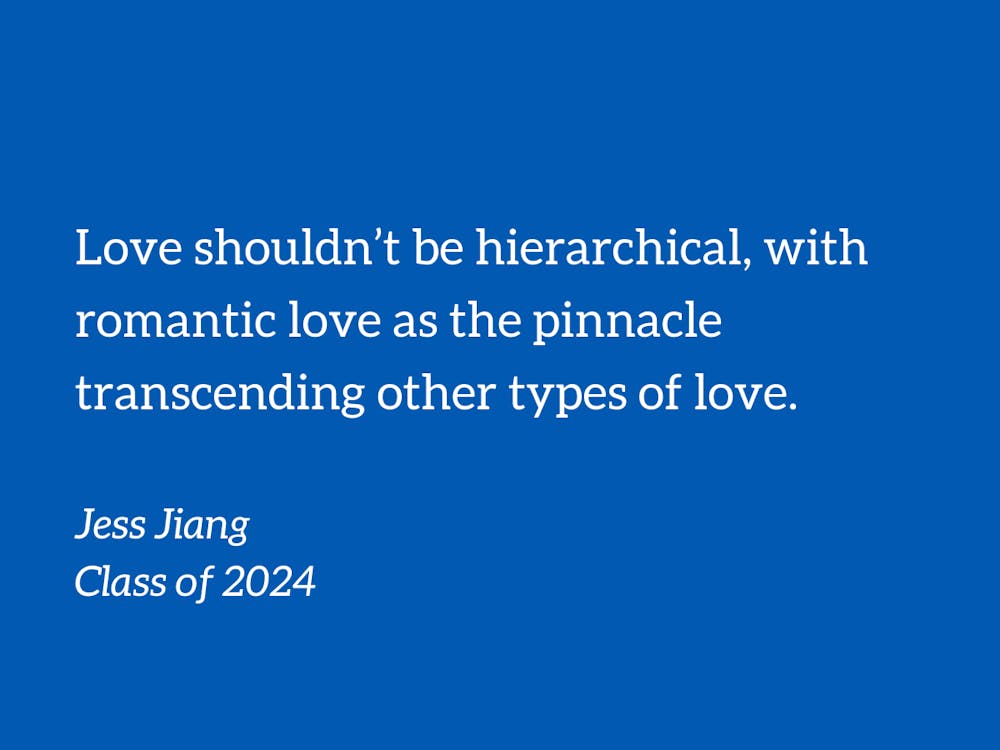Imagine that both your best friend and your romantic partner have fallen into a river. You can save one of them. What do you do?
Perhaps you’ve already dived in. But if you’ve got time to think before mortal danger befalls either of them, or if you’re the enlightened kind (like me) who knows that time heals all wounds and thus preemptively watches both get swept away to the land from which none return, then perhaps you’ll spend some time thinking over how we, as a society, view platonic and romantic relationships.
First off: What exactly is the difference between the two? Personally, I like to think of friends as separate individuals who have their own lives and romantic partners as … well, the opposite.
That sounds bad. Let me explain.
I’ve had several conversations with friends about what exactly romantic attraction is. As someone who experiences romantic attraction, the defining difference is that I think frequently and without conscious control about people I like romantically. Think intrusive thoughts, but pleasant, instead of distressing. Romantic love is sometimes compared to an addiction because it involves similar neural chemicals and brain activities. Don’t do cocaine, kids; just fall in love.
Perhaps simply because of romantic attraction, romantic partners are drawn to communicate with each other more frequently. I’ll posit that a blurring of identities also results from romantic relationships. Picture a Venn diagram: the one with the circles that don’t overlap represents you and your friend, the one with the circles that do overlap represents romantic partners. This idea is not new. Ever heard the expressions, “You complete me,” or, “You’re my better half,” used to refer to a romantic partner?
But is a romantic relationship necessarily better or more important than a friendship? Historically and scientifically, the answer has been no, not necessarily.
From the 1700s to the early 1900s, incredibly intimate same-sex friendships were more common, partially because women’s and men’s spheres were so separate and because sexuality wasn’t understood as an identity that could then be stigmatized. Only same-sex sexual acts were condemned — not same-sex desire or affection — so an intimate same-sex friendship wasn’t necessarily viewed with suspicion or prejudice.
But as our understanding of sexuality, our expectations around marriage and society itself changed, intimate friendships were deprioritized in favor of intimate romantic relationships.
Scientifically, there’s no reason to think that friends are any less important than romantic partners. Research shows that spending time with friends improves mental health more so than spending time with a spouse and that people are happiest when they’re with their friends and their spouse, not just their spouse.
Friendship comes with health benefits too. Large social networks are more effective than either exercise or dieting alone in decreasing the risk of premature death. A six-year study of Swedish men in their 50s found that having friends decreased the risk of heart attack and death from coronary heart disease, while having a partner did not. For older adults, social isolation is comparable to smoking, obesity and physical inactivity in increasing the risk of premature death from any cause. On the other hand, loneliness is associated with higher rates of depression, anxiety and suicide. That’s not the best of news, given that a U.S. survey found that in general people have fewer friends today than in the past, with the share of respondents reporting that they have no close friends rising from 3% in 1990 to 12% in 2021.
And yet, as a society, we value romance over friendship. The discrimination against single people is not just subtle or social, but also legal and financial. There are more than 1,000 U.S. laws that benefit only married people, affecting Social Security (which is primarily subsidized by singles based on the assumption that they will eventually marry), taxes (married couples can save thousands of dollars just by filing jointly), and health insurance. One article roughly estimates that the cost of being single is a little over $1 million over a lifetime assuming a fixed salary of $80,000 (about $1.32 million and $106,000 today, respectively) and a little under $500,000 assuming a fixed salary of $40,000 (about $641,000 and $53,000 today, assuming 2013 dollars).
In comparison, there are no similar legally recognized unions for committed platonic friends. That’s not to say that you can’t marry a platonic friend (which would be quite queerplatonic of you), but simply that the legal recognition of only romantic partnerships (i.e. marriage) discounts the similar importance of close friendships and contributes to a not-even-false belief that romantic relationships are more valuable than friendships (on the order of a million dollars, lifetime).
Love for a friend is different from love for a parent, which is different from love for a child, which is different from love for a romantic partner. But love shouldn’t be hierarchical, with romantic love as the pinnacle transcending other types of love. Yet, by cultural and institutional metrics in the U.S. — from legal discrimination against single people, to common phrases like “more than friends” that imply that friendship is characterized by a lack rather than a plenary, to the arophobia inherent in the assumption that everyone who is single would like to eventually be in a romantic relationship when some people simply don’t experience romantic attraction — it kind of is.
So, who do you save, the friend or the partner? Instinctively, you’d probably save the one you love more and would miss more, regardless of whether that love is romantic or platonic in nature. Logically, though, I’d advise you to go for the one who’ll net you those sweet, sweet married tax benefits.
Jess Jiang is a Trinity senior. Their column typically runs on alternate Wednesdays.
Get The Chronicle straight to your inbox
Signup for our weekly newsletter. Cancel at any time.

